ContactPost: Civil Aviation Authority of Viet Nam Telephone: +84 24 38274191 Fax: +84 24 38274194 Email: and@caa.gov.vn Web: http://caa.gov.vn | AIP Supplement for VIET NAM | AIP SUP 06/24 Effective from 01 FEB 2024 to PERM Published on 26 JAN 2024 |
ContactPost: Civil Aviation Authority of Viet Nam Telephone: +84 24 38274191 Fax: +84 24 38274194 Email: and@caa.gov.vn Web: http://caa.gov.vn | AIP Supplement for VIET NAM | AIP SUP 06/24 Effective from 01 FEB 2024 to PERM Published on 26 JAN 2024 |
This section supplements the following portion(s) of the AIP: AD.
On 17 MAR 2023, AIP SUP A11/23 was published to notify the trial operational procedure of airport collaborative decision making (A-CDM) at Tan Son Nhat International Airport.
On 19 OCT 2023, AIP SUP A41/23 was published to notify the continuation of trial operational procedure of airport collaborative decision making (A-CDM) at Tan Son Nhat International Airport.
In the present, A-CDM has been familiarized and applied by Airlines, Airport Operators, ATC Unit...
This AIP Supplement aims to provide information about the Airport Collaborative Decision Making (A-CDM) of Tan Son Nhat International Airport. Applicable time: From 1701 on 31 JAN 2024.
Airport Collaborative Decision Making (A-CDM) is a procedure agreed among units: Airport Operators, Airlines, Ground Handling Service, Air Traffic Control, Air Traffic Flow Management to collaboratively make decision at the airport in order to manage the congestion at the airport, increase the efficiency for departure aircraft, optimise the use of resource at the airport, enhance the ability of predicting and implementing exactly the process of a complete flight from departure phase till arrival phase.
All civil flights operating at Tan Son Nhat Airport must comply with A-CDM operational procedures except for VIP, emergency, medical, search and rescue flights.
The coordination among flights is based on the principal which flights/aircraft are best planned shall be served best (Best planned, Best served).
There are two core timestamps of A-CDM procedure: Target Off-Block Time (TOBT) and Target Startup Approval Time (TSAT), which shall be applied during operations at Tan Son Nhat International Airport.
A. TOBT and TSAT displays
TOBT and TSAT of flights are displayed on the pilot interface of A-CDM Portal
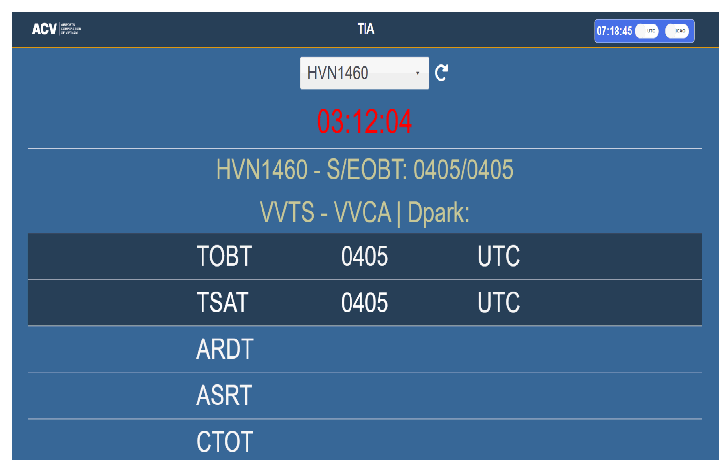
B. Guideline for Pilot interface of A-CDM Portal
Log-in
Go to https://acdm.vietnamairport.vn
Click “With Email”. Input Email and Password to Login.
Deselect “Use Password to login” to use login by OTP.

In default page: Choose Tan Son Nhat International Airport – real flights – base: SGN
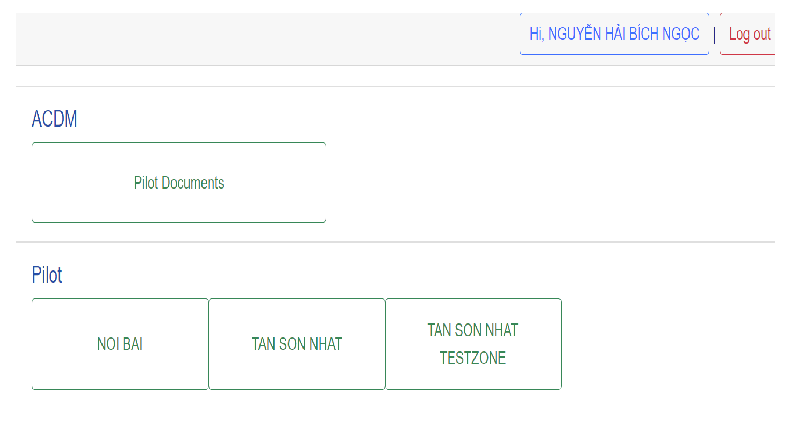
TSAT Countdown for Pilot
TSAT Countdown Timer for Pilot page has a feature to view pilot - specific data fields. These fields are synchronised in real time. These fields include: TOBT, TSAT, ASRT, ARDT, DPRK.
TSAT Countdown Timer for Pilot features
The real-time clock that defaults to UTC. If you want to change to Local time, click "convert toggle" button next to it;
Click on "Please Select Flight" drop down menu, then choose a flight;
When TOBT or TSAT of a flight is updated, that FDE will blink for 15s to indicate that the field has been updated.
Note: These flights are scheduled between -2 hours and +3 hours from the current time.
For Countdown Timer, when pilot selects a flight, one of these two cases will occur:
+ Case 1: If the selected flight has TSAT sooner more 5 minute than current time, the Countdown will be activated and indicated in orange
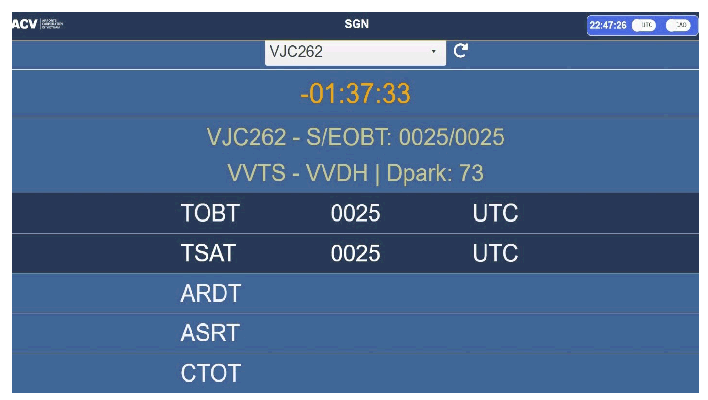
Countdown Timer will turn to green when the current time is within TSAT window +/-5 minutes.
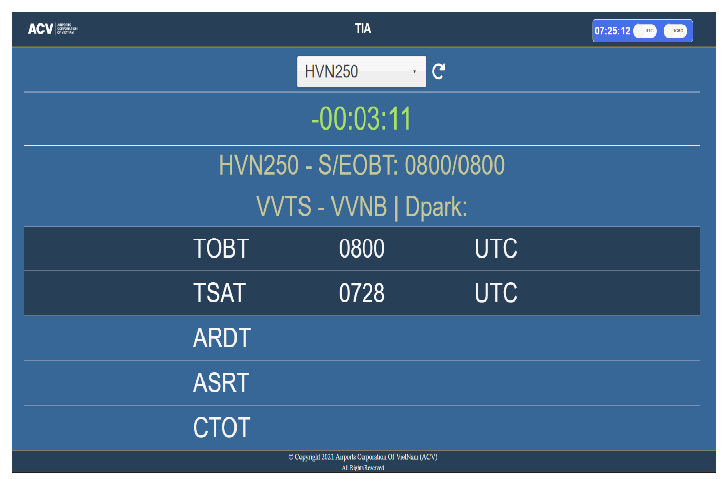
Countdown Timer will turn to red when the current time passes TSAT over 5 minutes.
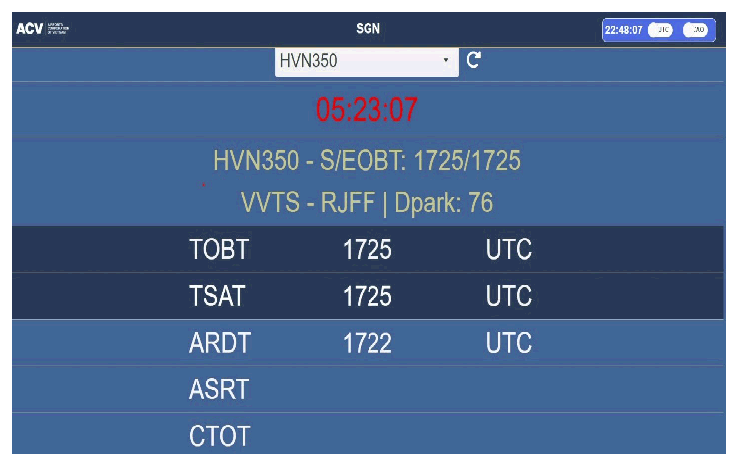
+ Case 2: If the selected flight does not have TSAT or the selected flight has ASAT, Countdown Timer will turn to “00:00:00”.
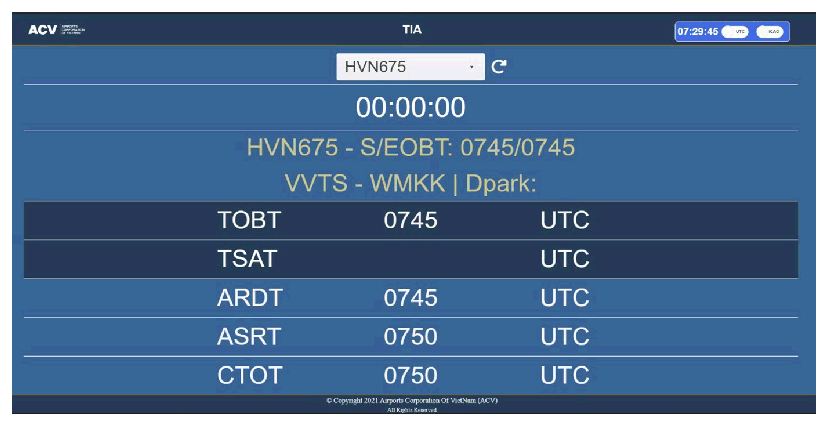
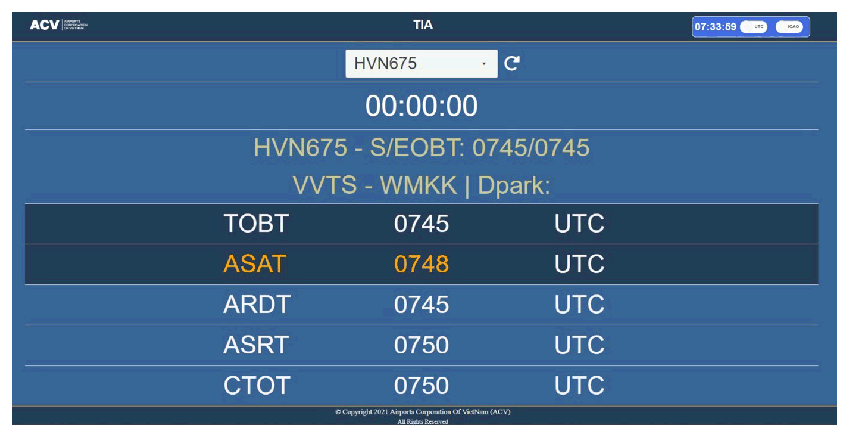
ACGT: Actual Commence of Ground handling Time
ALDT: The actual time that an aircraft touches down on the runway
AO: Airline Operator
ARDT: The point in time at which an aircraft is ready, which implies: all ground handling activities are finished, the flight preparation in the cockpit has finished, all doors are closed, and the boarding bridge and handling equipment removed, push back truck available and ready for immediate start and push back upon clearance from the Tower
ASRT: Actual Start Up Request Time. The time when the pilot requests start-up approval
ASAT: Actual Start Up Approval Time
CTOT: Calculated Take Off Time. The calculated time of take-off. CTOT is issued by the ATFMC as a result of an ATFM slot allocation and is a constraint in the planning of a TTOT.
EIBT: Estimated In-Block Time
ELDT: Estimated Landing Time
EOBT: The estimated time that an aircraft will depart from its stand.
EXIT: Estimated Taxi-In Time
ETTT: Estimated Turn-round Time
GH: Ground Handler
TOBT: The point in time at which the aircraft operator or ground handling estimates an aircraft to be ready: all ground handling activities are finished, the flight preparation in the cockpit has finished, all doors are closed and the boarding bridge and handling equipment are removed, push back truck is available and ready for an immediate start and push back upon clearance from the Tower.
TSAT: The time provided by ATC taking into account TOBT and CTOT, that an aircraft can expect to receive start-up / push back approval (start up and push back approval are issued together).
SOBT: Aircraft start taxi out of the current stand as planned. The time leaving stand of aircraft is issued base on based flight schedule determined at 22:00 by the Airline and the GH before the operational date.
Foreign airlines, private flights, charter flights, official duties aircraft shall authorise GH to submit flight schedule.
In operation day, EOBT will be updated by FPL or DLA/CHG messages, as detailed:
Proposal FPL will be submitted by AO to Tan Son Nhat ARO/AIS Centre via AMHS/AFTN or AIS/AIM/ or email or hard copy not later than:
150 minutes before EOBT for domestic flights that submit FPL remotely.
210 minutes before EOBT for international flights that submit FPL remotely.
60 minutes before EOBT when submitting hard copy of FPL to ARO/AIS centre.
AO shall notify ARO/AIS if new EOBT is available (for delay >30 minutes compared to EOBT).
Except for flights departing from Level 2 Multi-Nodal ATFM Airport to airports and airspace of Level 3 Multi-Nodal ATFM Network, ATS flight plan submission and relevant information about generating ATS message (including DLA, CNL, CHG messages) shall comply to the current ATFM Multi-Nodal operational procedure.
AO shall submit a new proposal FPL and notify Tan Son Nhat ARO/AIS and ATFMC if flight delays more than 60 minutes compared to old EOBT.
ALDT is actual time aircraft touch down RWY. When aircraft land, A-CDM Portal record ALDT by the ADS-B system, then this milestone is officially updated from SMIS through decoding of AFTN/AMHS messages. Then A-CDM Portal automatically calculate EIBT= ALDT + EXIT (estimated taxi-in time).
As soon as a flight schedule is updated into the A-CDM Portal system, the initial TOBT shall be calculated based on the FPL information and shall be set equal to the SOBT.
As soon as the estimated landing time of an arrival flight is defined, the 2nd TOBT will be automatically calculated when ELDT is received, following the formula: The 2nd TOBT= EIBT (ELDT+EXIT) + ETTT.
Changes of ELDT/EIBT will result in updating TOBT.
This automatic process will continue until the flight is actual arrive in-block (AIBT), TOBT= AIBT + ETTT
The new TOBT cannot be updated greater than 5 minutes before EOBT.
In case of aircraft parking overnight or aircraft swapping, TOBT will be automatically calculated based on ACGT with the formula: TOBT = ACGT + ETTT. GH is responsible to input ACGT when the ground-handling activities for the aircraft start as scheduled.
From this point onward, the GH is the main source for updating TOBT. The GH will consider available resources and their own planning as well as agreed procedures with airlines in updating the TOBT for flights.
Then, based on daily flight plan, the 1st TOBT will be set equal to EOBT (before TOBT calculated automatically following the formula).
For flights departing from Tan Son Nhat International Airport to airports and airspace of Level 3 Multi-Nodal ATFM Network, after ATFMC VN issue CTOT, AO/GH shall issue TOBT on A-CDM Portal base on EXOT.
Before 25 minutes to TOBT, GH and AO need to monitoring the TOBT to get the accuracy of +/-5min. In case ETTT of flight is less than 25 minutes, GH need to update TOBT as early as possible in order to avoid affecting the TSAT of flight which is approved to push back/ start up of departure flight.
Pilot should continue to monitor the TOBT to get the accuracy of +/-5min. If TOBT+/-5min is not achievable, pilot must inform GH to update TOBT.
Another source for updates of the TOBT can be the EOBT. Based on the FPL, if the EOBT is updated to a later time than the current TOBT, GH needs to update the TOBT.
TSAT: Provided by ATC via ACDM Portal based on updated TOBT data (via automatically calculate system or ground handlings update manually as requested by airlines), with reference to CTOT, restricted take off time and actual operating traffic condition, TSAT is calculated by ATC for each flight and then issued.
At TOBT-25 minutes, TSAT is planned by ATC to sequence the departure flight.
In normal operating conditions, TSAT = TOBT.
In case It is necessary to increase interval of departure traffic, ATC will update TSAT according to air traffic flow.
In addition, ATC are able to issue earlier TSAT based on current traffic when aircraft is reported full ready and assure that the takeoff time will be followed Flight Permission.
For flights departing from TIA to airports and airspace of Level 3 Multi-Nodal ATFM Network, ATC are responsible of planing and modify TSAT base on TOBT issued by AO/GH and actual operating traffic condition in order for ATOT of flight is within CTOT Compliance window (-5/+10 minutes).
Start-up procedure is based on a collaborative TSAT planning based on the TOBT received by ATC. At TSAT+/-5min, pilot will request to start up and push back when aircraft have full ready (displayed by ARDT on ACDM Portal).
TSAT window: +/- 5 minutes from TSAT. If the start-up clearance requested by pilots is within TSAT window, ATC is responsible for issuing start-up/push-back approval clearance if possible.
If start-up/push-back clearance requested by pilots is before TSAT window, ATC shall request pilots to call again for clearance within TSAT window.
If there is no start-up clearance requested by pilots within TSAT window, then the TSAT of the flight shall be considered as invalid and shall be removed from departure sequence.
If start-up clearance requested by pilots is after TSAT window, ATC shall not issue start-up clearance and request pilot to inform related units (AO, GH) to update TOBT in order to receive a new TSAT.
In case an ATC is unable to approve start-up clearance within TSAT window due to special reasons such as: VIP flight, adverse operational condition, pilots shall be notified to “stand by”, then ATC shall issue start-up clearance when possible.
Pilots shall check for updates of TOBT, TSAT directly on A-CDM Portal.
In case the pilot cannot check for the updating of TOBT, TSAT on A-CDM Portal, pilot shall be responsible for contacting with GH to receive TOBT, TSAT.
In case the pilot cannot contact GH, he/she shall be responsible for contacting with GH or ATC to receive TSAT via RT/VHF.
For flights that require an Idle engine start when technical failure:
The pilot requested to start the engine: ATC did not update the ASRT to the A-CDM Portal system.
After checking the engine and ready for departure, Pilot request start up for departure according to the current procedure. ATC updates ASRT to the A-CDM system.
For flights that require an idle engine start at gate/parking, the pilot shall actively estimate the idle engine start time to ensure that the aircraft will start all engines for departure within the TSAT window +/-5 minutes.
Flight is established SCH status in the system when:
Airlines schedule flight timetable for the next day and submit to Tan Son Nhat International Airport (TIA) and relating Ground handling (GH).
For airlines without representative at the airport, flight schedule shall be submitted by GH.
GH update flight schedule into SMIS/VMS to synchronise into A-CDM Portal.
Tan Son Nhat International Airport arrange stands for flights.
Flight is established INI status in the system when AO send proposal FPL to ARO/AIS via AMHS/AFTN system or AIS/AIM/email system or submit directly no later than:
150 minutes before EOBT for domestic flights that submit FPL remotely.
210 minutes before EOBT for international flights that submit FPL remotely.
60 minutes before EOBT when submitting proposal FPL directly at Tan Son Nhat ARO/AIS.
Flight is established FIR status in the system when:
Aircraft approach Ho Chi Minh FIR and start planning to arrange landing sequence for arrival aircraft.
ATC provide ELDT for ACDM Portal
At the time the aircraft arrives at the TMA area, the ACDM Portal system will record the ELDT time based on data received from the ADS-B system. The ELDT is next updated from the ADS-B signal when the aircraft descends to 7000 ft, 4900 ft and 2000 ft.
Flight is established FNL status in the system: final ELDT updated from the aircraft's ADS-B system at an altitude of 2 000 ft.
Flight is established LND status in the system when:
Aircraft land.
The time aircraft touch down RWY is the reference time for ALDT. ALDT is initially received from the ADS-B system, then the ACDM Portal system receives the data automatically from SMIS (updated from ATFN/AMHS).
Flight is established IBK status in the system when: Aircraft is into stands and GH unit accept flight AIBT value.
Flight is established BRD status in the system when: GH unit update the time customers start boarding by inserting ASBT in the system or directly insert into A-CDM Portal, based on the time the first boarding card scanned at the boarding gate.
Flight is established RDY status in the system when: GH services are completed and ARDT is inserted in SMIS/VMS.
Flight is established OBK status in the system when:
Aircraft is out of the stand;
GH Agent inserts AOBT in the system. A-CDM Portal updates AOBT from SMIS/VMS.
Flight is established DEP status in the system when:
Aircraft depart from RWY;
A-CDM Portal receive initial ATOT from the ADS-B system, then is officially updated by SMIS from decoding the DEP message from ATFN/AMHS.
In case the A-CDM live operation is postponed due to TOBT or TSAT becoming unavailable, Pilot and ATCs shall resume "First come, first served" operational procedure. The temporary discontinuation or the resumption of the A-CDM live trial shall be notified by NOTAM.
This AIP Supplement shall supersede: AIP SUP A41/23.
This AIP Supplement shall remain in force until its content has been incorporated into the AIP Viet Nam.